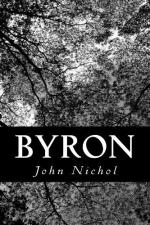On his own death in 1798, the estates and title passed to George Gordon, then a child of ten, whom he used to talk of, without a shadow of interest, as “the little boy who lives at Aberdeen.” His sister Isabella married Lord Carlisle, and became the mother of the fifth Earl, the poet’s nominal guardian. She was a lady distinguished for eccentricity of manners, and (like her son satirized in the Bards and Reviewers) for the perpetration of indifferent verses. The career of the fourth lord’s second son, John, the poet’s grandfather, recalls that of the sea-kings from whom the family claim to have sprung. Born in 1723, he at an early age entered the naval service, and till his death in 1786 was tossed from storm to storm. “He had no rest on sea, nor I on shore,” writes his illustrious descendant. In 1740 a fleet of five ships was sent out under Commodore Anson to annoy the Spaniards, with whom we were then at war, in the South Seas. Byron took service as a midshipman in one of those ships—all more or less unfortunate—called “The Wager.” Being a bad sailor, and heavily laden, she was blown from her company, and wrecked in the Straits of Magellan. The majority of the crew were cast on a bleak rock, which they christened Mount Misery. After encountering all the horrors of mutiny and famine, and being in various ways deserted, five of the survivors, among them Captain Cheap and Mr. Byron, were taken by some Patagonians to the Island of Chiloe, and thence, after some months, to Valparaiso. They were kept for nearly two years as prisoners at St. Iago, the capital of Chili, and in December, 1744, put on board a French frigate, which reached Brest in October, 1745. Early in 1746 they arrived at Dover in a Dutch vessel.




